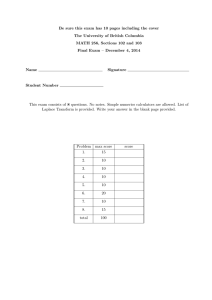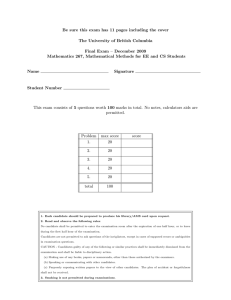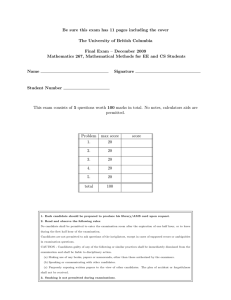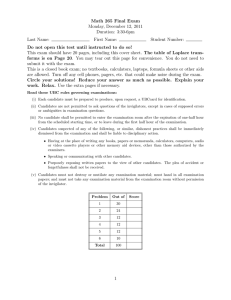Math 301 Final Exam Apr 24, 2008 Duration: 150 minutes Name:
advertisement
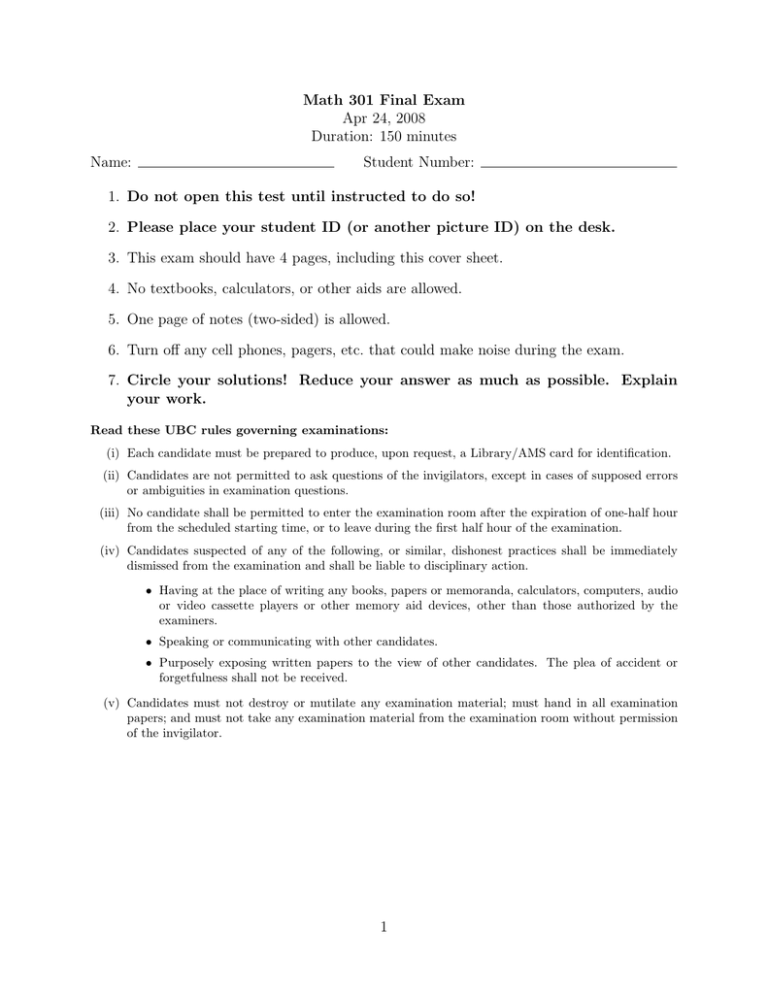
Math 301 Final Exam
Apr 24, 2008
Duration: 150 minutes
Name:
Student Number:
1. Do not open this test until instructed to do so!
2. Please place your student ID (or another picture ID) on the desk.
3. This exam should have 4 pages, including this cover sheet.
4. No textbooks, calculators, or other aids are allowed.
5. One page of notes (two-sided) is allowed.
6. Turn off any cell phones, pagers, etc. that could make noise during the exam.
7. Circle your solutions! Reduce your answer as much as possible. Explain
your work.
Read these UBC rules governing examinations:
(i) Each candidate must be prepared to produce, upon request, a Library/AMS card for identification.
(ii) Candidates are not permitted to ask questions of the invigilators, except in cases of supposed errors
or ambiguities in examination questions.
(iii) No candidate shall be permitted to enter the examination room after the expiration of one-half hour
from the scheduled starting time, or to leave during the first half hour of the examination.
(iv) Candidates suspected of any of the following, or similar, dishonest practices shall be immediately
dismissed from the examination and shall be liable to disciplinary action.
• Having at the place of writing any books, papers or memoranda, calculators, computers, audio
or video cassette players or other memory aid devices, other than those authorized by the
examiners.
• Speaking or communicating with other candidates.
• Purposely exposing written papers to the view of other candidates. The plea of accident or
forgetfulness shall not be received.
(v) Candidates must not destroy or mutilate any examination material; must hand in all examination
papers; and must not take any examination material from the examination room without permission
of the invigilator.
1
1. (15 points) Evaluate the principal value integrals.
Z ∞ 2ix
e
dx
(a)
I1 =
−∞ x − i
Z ∞
cos 2x
dx
(b)
I2 =
−∞ x − i
2. (15 points) We define a fixed point of a function f (z) to be any z0 for which f (z0 ) = z0
and recall that a Möbius transformation is a function M(z) of the form
M(z) =
az + b
cz + d
subject to the requirement ad 6= bc.
(a) Find conditions on a, b, c, d that guarantee that every point z ∈ C is a fixed point
of M(z).
(b) Construct a Möbius transformation M(z) with c 6= 0 that has a fixed point at
z0 = 1 + i, and no other fixed points.
(c) Assuming c 6= 0, specify the minimum and maximum numbers of fixed points that
M(z) can have. (Justify your answer.) Interpret your answer geometrically.
3. (15 points) Let D be the part of the complex plane satisfying Im(z) > 0 and |z − i| < a
where 0 < a < 1.
(a) Find a conformal map of D onto a region bounded by concentric circles centered
at the origin.
(b) Find a solution of Laplace’s equation ∇2 φ = 0 on the region D subject to the
boundary condition that φ = 1 on the circle |z − i| = a and φ = 0 on the line
Im(z) = 0.
(c) Now consider the case a = 1 so the circle touches the real axis in the z-plane. Verify
that the corresponding solution of Laplace’s equation is given by
z − 2i
2y
φ(x, y) = 1 − Re
= 2
z
x + y2
where z = x + iy.
(d) Is it possible to obtain the formula of part (c) by taking the limit a → 1 in the
solution of part (b)? Explain why or why not on physical grounds.
2
4. (15 points) Consider the following initial value problem:
with
y (4) + ky ′′′ + y ′′ + y ′ = e−t , k ≥ 0
y(0) = 1, y ′(0) = y ′′ (0) = y ′′′(0) = 0.
(a) Calculate Y (s), the Laplace transform of the solution y(t).
(b) Let k = 2. Prove that y(t) is bounded. Hint: use Nyquist criterion/argument
principle.
5. (10 points) Use the Fourier transform to solve the diffusion equation:
ut = Duxx
− ∞ < x < ∞,
u(x, 0) = f (x)
u(x, t) → 0 as |x| → ∞.
t>0
You can freely use the following result for the Fourier Transform of a Gaussian function:
f (x) = √
1
2
2
e−x /σ
2πσ
2 2
fˆ(k) = e−σ k /2
6. (10 points) Let P (z) and Q(z) be two polynomials such that deg(Q) ≥ 2 + deg(P ).
Suppose {z1 , . . . , zn } is the set of all distinct poles of P (z)/Q(z).
(i) Show that
n
X
j=1
Res{P (z)/Q(z); zj } = 0.
(ii) What is Res{P (z)/Q(z); ∞}?
7. (10 Points) Calculate the Fourier transform of
(
e−2t cos(t) t ≥ 0
f (t) =
0
t < 0.
Hint: Use the connection between Fourier and Laplace transforms.
3
8. (10 points) (a) Explain briefly how we can use contour integration to calculate
∞
X
1
.
2
k
k=1
(Provide a sketch of necessary steps.)
(b) Explain why the same technique cannot be used to evaluate
∞
X
1
.
3
k
k=1
4
